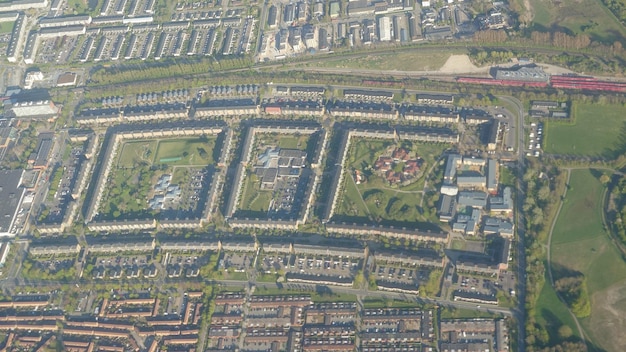QOZs in 2025: Navigating Qualified Opportunity Zones for Viable Investments

Qualified Opportunity Zones (QOZs), established in 2017 to spur economic development in distressed communities, continue to offer potential tax benefits in 2025, but require careful navigation due to evolving regulations, market conditions, and the complexities of qualifying investments.
Are navigating the complexities of Qualified Opportunity Zones (QOZs) in 2025 still a viable investment option? Created by the Tax Cuts and Jobs Act of 2017, QOZs aimed to stimulate economic development in distressed communities by offering tax incentives to investors. As we approach 2025, the landscape has evolved, raising important questions about the continued appeal and effectiveness of these zones.
Understanding Qualified Opportunity Zones (QOZs)
Qualified Opportunity Zones (QOZs) are designated areas across the United States identified as economically distressed communities. These zones were established to encourage private investment in these areas through various tax incentives, aiming to revitalize local economies and create jobs.
Key Features of QOZs
QOZs operate under a specific set of regulations and guidelines that investors must adhere to in order to qualify for tax benefits. These features are designed to ensure that investments are truly contributing to community development.
The primary goal is to attract long-term capital investments that foster sustainable growth. This involves understanding the criteria for selecting QOZs and how investments can be structured to meet these requirements.
- Designation Criteria: Zones are selected based on factors such as poverty rates, unemployment levels, and lack of economic activity.
- Investment Requirements: To qualify, investments must be made through a Qualified Opportunity Fund (QOF) and substantially improve the QOZ property.
- Tax Benefits: Investors can defer, reduce, and potentially eliminate capital gains taxes by investing in QOFs that meet specific holding period requirements.

Understanding these aspects is crucial for anyone considering investing in QOZs. It’s not just about chasing tax benefits; it’s about making impactful investments that can drive positive change in underserved communities.
The Tax Benefits of Investing in QOZs
The primary incentives for investing in Qualified Opportunity Zones revolve around significant tax advantages. These benefits are designed to encourage patient capital and long-term investments.
Understanding the specifics of the tax benefits can make QOZs an attractive option for investors looking to minimize their tax liabilities while contributing to economic development in targeted areas.
Deferral, Reduction, and Elimination of Capital Gains Taxes
The tax benefits come in three main forms: deferral, reduction, and potential elimination of capital gains taxes. Each benefit is tied to the length of time the investment is held within the QOF.
- Deferral: Investors can defer capital gains taxes on the sale of assets by reinvesting the gains into a QOF within 180 days.
- Reduction: If the QOF investment is held for at least five years, the deferred capital gains tax is reduced by 10%. Holding it for at least seven years increases the reduction to 15%.
- Elimination: If the investment is held for ten years or more, any capital gains generated from the QOF investment itself are permanently excluded from taxable income.
These incentives are structured to reward long-term commitment to QOZ projects, aligning investor interests with the economic goals of the program.
Assessing the Viability of QOZs in 2025
As we approach 2025, it’s crucial to assess whether Qualified Opportunity Zones remain a viable investment option. Several factors influence their attractiveness, including regulatory changes, market conditions, and the maturity of the program itself.
A comprehensive evaluation requires examining both the potential benefits and the inherent risks associated with investing in QOZs in the current economic climate.
Regulatory Changes and Program Maturity
Since their inception, QOZs have been subject to various regulatory adjustments and clarifications. These changes can impact the compliance requirements and investment strategies for QOFs.
Additionally, as the program matures, more data becomes available on the performance of QOZ investments, providing insights into their effectiveness and potential for future growth.
- Legislative Updates: Monitor any legislative changes that could affect the tax incentives or eligibility criteria for QOZs.
- Performance Data: Review available data on QOZ investment performance to evaluate the success rates and identify promising sectors.
- Compliance Requirements: Stay informed about compliance requirements to ensure QOFs adhere to all regulations and maintain their eligibility for tax benefits.
Keeping abreast of these developments is essential for making informed decisions about QOZ investments.

Challenges and Risks Associated with QOZ Investments
Investing in Qualified Opportunity Zones is not without its challenges and risks. These factors can impact the success and profitability of QOZ investments.
Understanding these challenges is critical for investors to make informed decisions and mitigate potential risks.
Economic Uncertainty and Market Volatility
Economic uncertainty and market volatility can significantly affect the performance of QOZ investments. These factors can impact property values, business operations, and overall economic activity in QOZs.
Furthermore, QOZs are often located in areas that are inherently more vulnerable to economic downturns, which can exacerbate these risks.
Investors should carefully evaluate the local economy and market conditions in each QOZ before committing capital. This includes assessing factors such as employment rates, income levels, and housing affordability.
Strategies for Successful QOZ Investing in 2025
To maximize the potential benefits of investing in Qualified Opportunity Zones in 2025, investors need to adopt effective strategies that mitigate risks and capitalize on opportunities.
A thoughtful approach involves careful due diligence, diversification, and a focus on long-term value creation.
Due Diligence and Opportunity Fund Selection
Thorough due diligence is essential for identifying viable QOZ investments. This includes evaluating the local economy, assessing project feasibility, and reviewing the track record of the opportunity fund managers.
Selecting the right opportunity fund is also crucial. Investors should look for funds with experienced management teams, a clear investment strategy, and a commitment to community development.
Consider these key factors when choosing a QOF:
- Management Expertise: Assess the experience and expertise of the fund managers.
- Investment Strategy: Understand the fund’s investment strategy and how it aligns with your goals.
- Community Impact: Evaluate the fund’s commitment to community development and its potential impact.
By conducting thorough due diligence and selecting the right opportunity fund, investors can increase their chances of success in QOZ investments.
Future Outlook for Qualified Opportunity Zones
The future outlook for Qualified Opportunity Zones remains cautiously optimistic. While challenges persist, the program’s potential to drive economic development in underserved communities is undeniable.
As we look ahead, several factors will shape the trajectory of QOZs, including policy developments, market trends, and the evolving needs of the communities they serve.
Policy Developments and Long-Term Viability
The long-term viability of QOZs depends on continued policy support and adaptation to changing economic conditions. Policymakers may consider further adjustments to the program to enhance its effectiveness and address any shortcomings.
Moreover, the success of QOZs will depend on the ability of local communities to leverage these investments to create sustainable economic growth and improve the quality of life for residents.
Here are key areas to watch:
- Policy Adjustments: Monitor for any changes to the tax incentives or eligibility criteria for QOZs.
- Community Engagement: Assess the level of community engagement in QOZ projects and their impact on local residents.
- Long-Term Sustainability: Evaluate the long-term sustainability of QOZ investments and their ability to generate lasting economic benefits.
By staying informed about these developments, investors and policymakers can work together to ensure that QOZs continue to serve as a valuable tool for economic development in the years to come.
| Key Aspect | Brief Description |
|---|---|
| 📍 QOZ Definition | Designated areas for stimulating economic growth through tax incentives. |
| 💰 Tax Benefits | Offer deferral, reduction, and potential elimination of capital gains taxes. |
| ⚠️ Key Challenges | Include economic uncertainty, regulatory changes, and compliance complexities. |
| ✅ Strategies | Due diligence, fund selection, and community impact focus are vital. |
Frequently Asked Questions About QOZs
▼
A Qualified Opportunity Zone (QOZ) is a designated area in the United States that is identified as economically distressed and eligible for certain tax benefits to spur economic development through private investments.
▼
The primary tax benefits include deferral of capital gains taxes, a potential reduction of those taxes if the investment is held for at least five or seven years, and potential elimination of capital gains on the QOZ investment itself if held for ten years or more.
▼
To invest in a QOZ, you need to invest through a Qualified Opportunity Fund (QOF). A QOF is an investment vehicle that is organized for the purpose of investing in QOZ property.
▼
Risks include economic uncertainty, market volatility, regulatory changes, compliance complexities, and the potential for projects to underperform due to various factors affecting the local economy.
▼
Whether QOZs are a good investment in 2025 depends on various factors, including regulatory updates, market conditions, and individual investment goals. Careful assessment and due diligence are essential.
Conclusion
Navigating the complexities of Qualified Opportunity Zones (QOZs) in 2025 requires a comprehensive understanding of their benefits, risks, and evolving landscape. While QOZs continue to offer attractive tax incentives and the potential for impactful community development, investors must approach these investments with diligence, strategic planning, and a commitment to long-term value creation.





